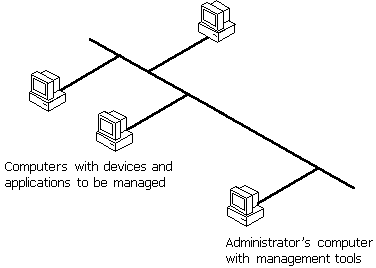
Businesses need the ease-of-use, productivity, and cost benefits of personal computers, but they also want the control of mainframe computing. In todayís distributed environments, the distinction between systems and network management disappears, and management issues are more difficult to resolve.
The system management tools and agents provided with Windows 98 support system management in three areas:
Windows 98 also provides registry-based support for remote management of configuration settings for hardware and software settings ó either on individual computers or on multiple computers (through system policies) on the network.
The remote management tools provided with Windows 98 make it easier for you to identify and solve problems encountered by users without dispatching support personnel to make changes at the usersí work sites. The tools include System Policy Editor, Registry Editor, System Monitor, and Net Watcher.
You can enable remote administration capabilities on a computer as part of the process for installing Windows 98 from custom scripts. For more information, see Appendix D, "Msbatch.inf Parameters for Setup Scripts."
You can manage file systems remotely by browsing specific computers in Network Neighborhood, as described in "Using Network Neighborhood" later in this chapter.
Windows 98 also provides an agent for Microsoft Network Monitor and a Simple Network Management Protocol (SNMP) agent for administration with SNMP system management products, as described in "Using Microsoft Network Monitor" and "Using an SNMP Agent" later in this chapter.
Figure 23.1 provides an overview of system and remote administration.

Figure 23.1 System and remote administration overview
The following sections summarize features in Windows 98 that support system and remote management on corporate networks.
Security for system logon and resource access.
Administrators can take advantage of centralized user accounts on Windows NT or Novell NetWare networks to restrict network logon and access to shared resources on computers running Windows 98. Windows 98 provides password caching to make it easier for users to manage connections to password-protected resources yet also allows network administrators to restrict usersí capabilities. Consequently, administrators can enforce strict security policies. For information, see Chapter 9, "Security."
User profiles.
When user profiles are enabled, individual users and desktop configurations are available wherever they log on to the network. This solution permits multiple users to share one computer and "roving" users to log on to other networked computers while maintaining their personal settings. Administrators can also enforce a mandatory user profile, which can be useful for managing a common desktop for novice users. For information, see Chapter 7, "User Profiles."
System policies.
Administrators can use system policies to specify required system settings and to restrict network access, security privileges, and system settings from a convenient central source. Policies can be specified for groups, for specific users, and for multiple computers, providing administrators significant control over usersí ability to configure computer and desktop settings. For information, see Chapter 8, "System Policies."
Remote administration.
Built-in capabilities for remote administration assist administrators in managing networking computers from a central location, reducing the burden of supporting system configuration and troubleshooting on the corporate network.
Backup capabilities.
Windows 98 includes an improved version of the Microsoft Backup utility. The improved version supports a wider range of backup devices than the Windows 95 backup utility. For information about Microsoft Backup, see Chapter 27, "General Troubleshooting."
Windows 98 registry.
In Windows 98, the operating system collects information about the hardware, system configuration settings, and applications and stores it in the registry. The Windows 98 registry is a structured database that consolidates configuration and status information for hardware and software components. As a result, this information is available to system management applications, ensuring flexible system management capabilities. For information, see Chapter 31, "Windows 98 Registry."